WHAT IS IT?
Nuclear medicine is a medical specialty that uses radioisotope/radionuclide-containing radiopharmaceuticals to diagnose, evaluate, treat, and monitor diseases.1,2

Radiopharmaceuticals are medicinal products approved for diagnosis and/or therapy that contain radioisotopes, also called radionuclides,3 which can be attached to a molecule used as a delivery agent.1
A radioisotope or radionuclide is an unstable atom that emits energy in an effort to become stable – this process is known as decay.4 It forms the active part of the radiopharmaceutical, which could be used for diagnostic or therapeutic purposes, depending on the type of radiation given off by the radioisotope/radionuclide.3
A delivery agent is a molecule used to deliver the radioisotope/radionuclide to the desired location within the body. Delivery agents can either be a molecule that is attracted to or is absorbed by a particular organ, tissue, specific biomarker, or receptor on a certain type of cell.5
Radiopharmaceuticals are adaptable in the ways they can be used for various diseases. Both the delivery agent and the radioisotope/radionuclide can be changed depending on the specific intended use.3
Radiation is a type of energy traveling in the form of waves or particles through space or material.6
Radiation exists naturally in our environment.1 In everyday life, we are exposed to different amounts of background radiation from:
• Natural sources including air, water, vegetation, and the food we eat
• Modern activities such as watching TV and flying in an airplane1
Radiation is also employed in a number of medical procedures such as x-rays, computed tomography (CT) scans, radiotherapy, and nuclear medicine.
There are 2 types of radiation: nonionizing radiation and ionizing radiation
• Nonionizing radiation is a type of low-energy radiation that does not have enough energy to cause chemical changes. Nonionizing radiation includes visible, infrared, and ultraviolet light; microwaves; radio waves; and radiofrequency energy from cell phones7
• Ionizing radiation is a type of high-energy radiation that has enough energy to remove an electron (negative particle) from an atom or molecule, causing it to become “ionized.”8 Ionizing radiation can cause chemical changes in cells and damage DNA8
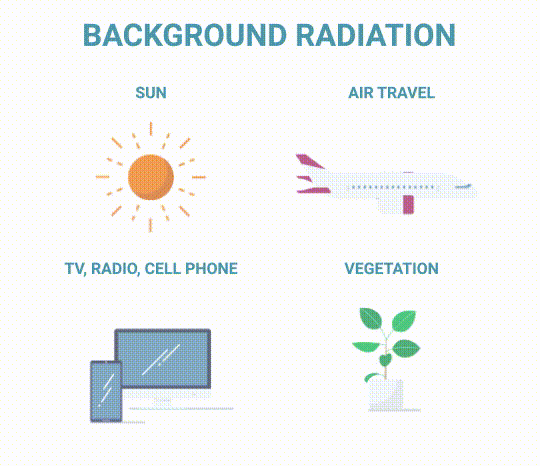
Radioisotopes/radionuclides and radiopharmaceuticals can give off 3 types of radiation.6

Alpha particles are relatively large and powerful compared with other types of radiation, but do not travel very far. They are used primarily for treatment as they can damage and kill diseased cells.9

Beta particles are smaller, faster, and more penetrating than alpha particles, and can cause a little less damage. They are also used primarily for treatment as they can damage and kill diseased cells.9

Gamma rays can pass through the human body and are detected or read using specialized cameras, making them useful for imaging, or making pictures of the body.1,6

HOW DOES IT WORK?
In nuclear medicine, radiopharmaceuticals are chosen for their ability to target a specific area of the body and to release a certain type of radiation to image or destroy malfunctioning cells.9
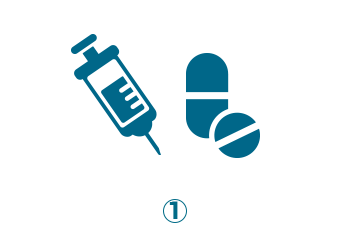
A radiopharmaceutical is administered,
or given, to a patient9 (by injection,5 swallowed,5 or through a catheter10 tube inserted into the body)
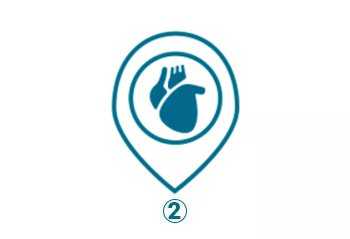
It searches for and travels
to a specific tissue or organ9
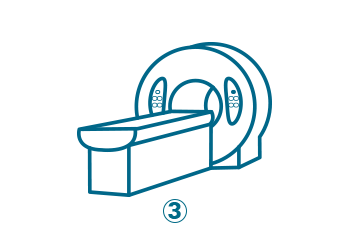
It releases a certain type of radiation which is either used to9:
• Locate where the radioisotope/radionuclide is in the body and form a picture of that particular area of tissue (imaging)
• Cause damage to particular cells (therapy)
HOW IS IT USED?
Nuclear medicine is very important to the care of patients across a wide range of diseases, either for diagnostic imaging procedures to form a picture of what is going on inside the body or as treatment.1
Nuclear medicine diagnostic imaging examples

Neurological disorders11 having to do with the brain or nervous system
Seeing blood flow to/from the brain and certain types of brain activity for Alzheimer disease, stroke, epilepsy, Parkinson disease, mental disorders, etc.

Heart disease11
Seeing blood flow to/from the heart and heart function to diagnose heart diseases such as heart attack, heart failure, heart rhythm problems, heart muscle disease, etc.

Bone disease12
Seeing any spread of cancer to the bones, bone infections, or bone diseases that can cause flaws or deformities of bone12,14

Cancer11
Picturing a tumor or the spread of cancer
~1 in 50
people undergo diagnostic nuclear medicine
procedures each year (in developed countries)13
Nuclear medicine Therapy

Bone disease
Treatment of cancer that has spread to the bone, bone infection, or bone diseases that can cause flaws or deformities of bone 12,14

Cancer11
Treatment of tumors or the spread of cancer
1 in 500
people are treated with nuclear medicine
each year (in developed countries)13
USES OF NUCLEAR MEDICINE IN CANCER
In nuclear medicine procedures, small amounts of radioactive materials are administered or given to patients to diagnose or treat cancer from the inside.1

Nuclear medicine is an important imaging and therapeutic tool for patients with many types of cancers11,15

In oncology, radiopharmaceuticals help physicians to visualize what is happening in your body at a cellular level.2
Radiopharmaceuticals provide information that may otherwise be difficult to obtain with other imaging technologies. Nuclear medicine imaging can help find, evaluate, and monitor cancer, and may help select the most appropriate therapy for a specific patient.2

When it comes to treating cancer, the focused nature of radiopharmaceuticals allows physicians to deliver the treatment to the target organ or tissue while the goal of maintaining low radiation exposure to other healthy tissues and organs.1
Theranostics is a term often used to describe a personalized disease management approach in nuclear medicine. The term “theranostics” comes from combining the words “therapy” and “diagnostics.”
With this approach, physicians use 2 types of radiopharmaceuticals based on the same or a similar delivery agent for both the diagnosis of and therapy for a particular disease.16
If a tumor is detected by a diagnostic radiopharmaceutical, the patient may be selected for nuclear medicine therapy using a therapeutic radiopharmaceutical with the same or a similar delivery agent.16,17
For patients, a theranostic approach may offer benefits by17:
• Proving the presence or absence of certain markers disease in an individual’s body
• Tailoring treatment to patients who might be more likely to receive benefit
• Reducing or eliminating unnecessary treatment
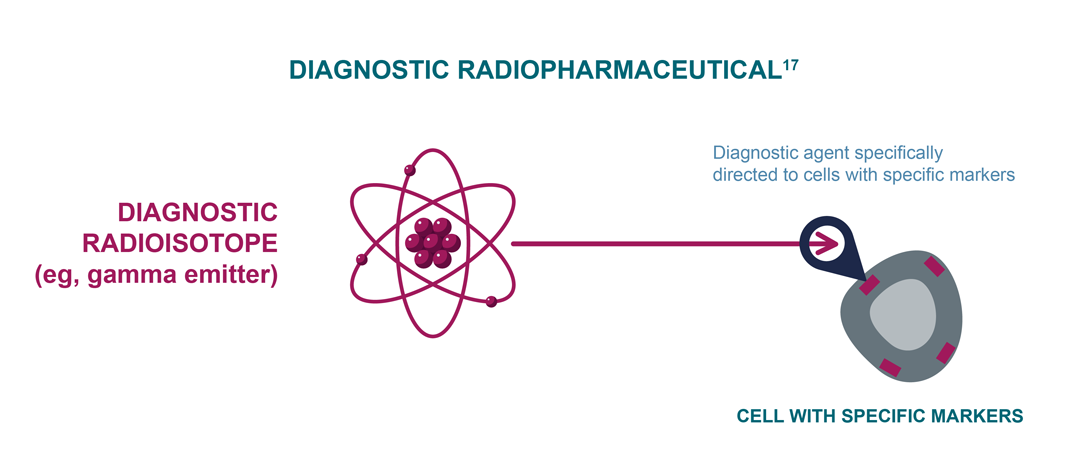
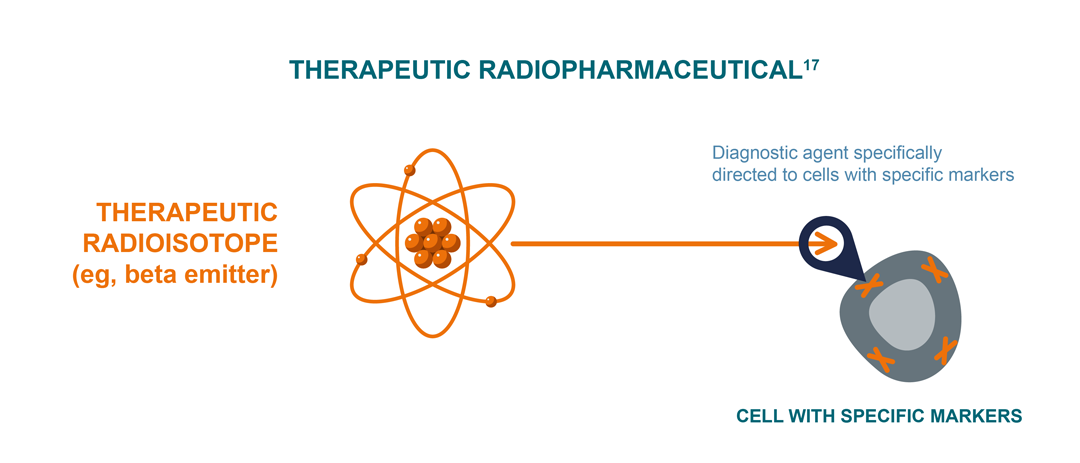
IS IT NEW?
Nuclear medicine is a well-established medical specialty. It has been used in the area of cancer for over 70 years.18
The development of nuclear medicine has benefited from advances in 3 technologies19:
• Nuclear physics
• Radionuclide chemistry
• Specialized equipment and instruments
From discovery…
The history of nuclear medicine began in the late 1890s with the accidental discovery of radioactivity.19 As scientists began to look more closely, they discovered that radioactive atoms give off particles and/or energy, in a process known as radioactive decay.6 Polonium and radium were discovered by Pierre and Marie Curie over this period.6
... and imaging uses
The first scanner was invented in 1950; it detected radiation and turned it into a picture of a part of the body.19
... to first therapeutic uses
Rapidly, radioisotopes/radionuclides started to be investigated as potential treatments in multiple medical areas such as cancer and endocrine disease, leading to the approval of iodine-131 to treat thyroid disease in 1951.19

WHAT SHOULD YOU KNOW ABOUT RADIATION?
A number of medical procedures use radiation.
For imaging
X-rays used in CT scans obtain images by sending radiation from an external source through the body.1
In nuclear medicine imaging, cameras detect or see the radiation that comes from the imaging radiopharmaceutical administered to the patient.1
For therapy
External beam radiotherapy is used to treat cancer by sending a focused dose of radiation through the body, right into the tumor.8
This is different from nuclear medicine treatments, which are given internally and deliver the dose of radiation to a targeted part of the body.9
Treatment with nuclear medicine therapy will expose you to radiation,
which can contribute to your long-term radiation exposure.
Nuclear medicine procedures are carefully monitored.

Short-lived
The radioisotopes/radionuclides used in nuclear medicine are especially selected for their very short half-life, meaning that they stop producing radiation quickly, usually within a few hours or days.1

Home care precautions
Your care team will provide you with specific safety and home care instructions following the procedure.1

Pregnant women
As with any other medical exam or procedure, pregnant and breastfeeding women should inform their doctors.1 Specific precautions should be taken to prevent unnecessary exposure of the baby to the radiopharmaceuticals.1

Radiation level
During nuclear medicine procedures, health care professionals take all necessary precautions to ensure that radiation levels – which are strictly controlled by regulators – are kept within required limits for you and for them.

Dose adaptation
Depending on the type of nuclear medicine being used, doses may be adapted to age and weight.22
As with all medical procedures, it is important for patients to be informed about the particular test or treatment they are receiving.
If you have any specific concerns, ask your doctor.
Today, nuclear medicine procedures are routinely used across many medical specialties.13
OVER 40 MILLION
nuclear medicine procedures are performed each year.13
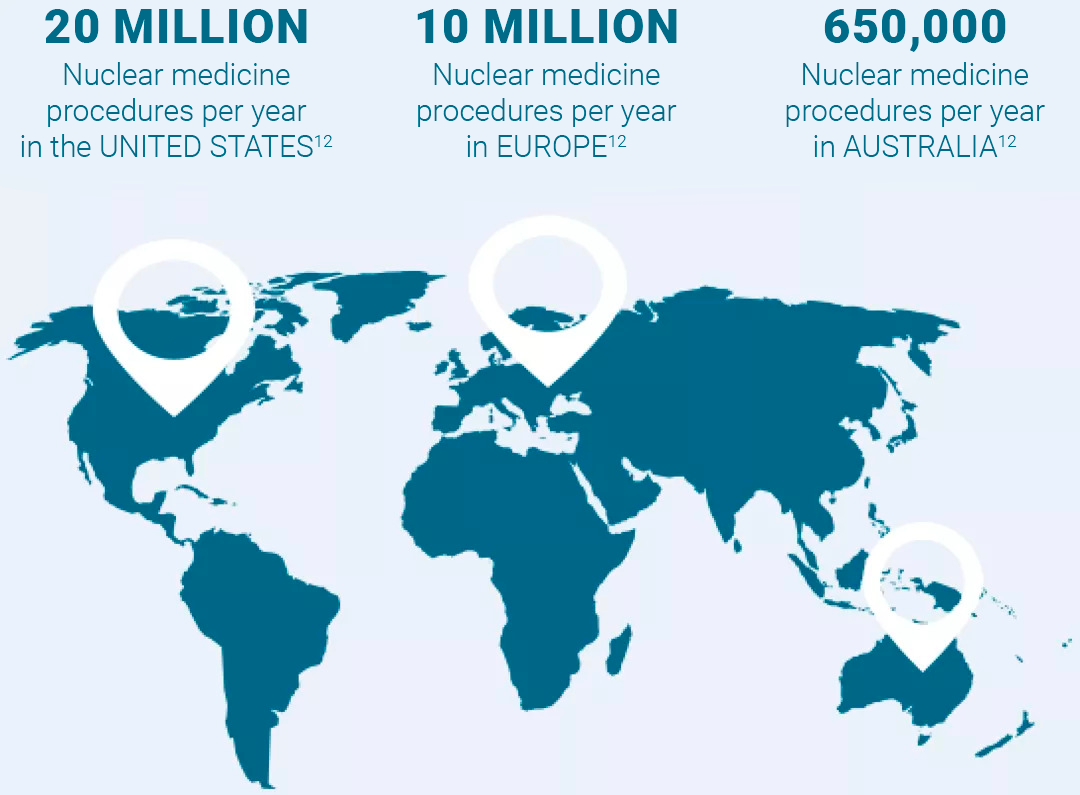
References:
1. Society of Nuclear Medicine and Molecular Imaging. Nuclear medicine and radiation safety. http://www.snmmi.org/Patients/About/content.aspx?ItemNumber=22909. Accessed June 1, 2020. 2. Society of Nuclear Medicine and Molecular Imaging. Fact sheet: molecular imaging and cancer. https://www.snmmi.org/AboutSNMMI/Content.aspx?ItemNumber=5653. Accessed June 28, 2020. 3. World Health Organization. The International Pharmacopoeia. 9th ed. Geneva: World Health Organization; 2019. https://apps.who.int/phint/en/p/docf/. Accessed February 16, 2021. 4. US Nuclear Regulatory Commission. Radioisotope (radionuclide). https://www.nrc.gov/reading-rm/basic-ref/glossary/radioisotope-radionuclide.html. Accessed June 1, 2020. 5. Radioactivity.eu.com. Tracers in medicine. https://www.radioactivity.eu.com/site/pages/Tracers_Medicine.htm. Accessed June 1, 2020. 6. Donya M, Radford M, ElGuindy A, Firmin D, Yacoub MH. Radiation in medicine: Origins, risks and aspirations. Glob Cardiol Sci Pract. 2014;2014(4):437–448. 7. Centers for Disease Control and Prevention. The electromagnetic spectrum: non-ionizing radiation. https://www.cdc.gov/nceh/radiation/nonionizing_radiation.html. Accessed June 1, 2020. 8. National Cancer Institute, Dictionary of Terms. Ionizing radiation. https://www.cancer.gov/publications/dictionaries/cancer-terms/def/ionizing-radiation. Accessed November 24, 2020. 9. Zimmerman R. Nuclear Medicine Radioactivity for Diagnosis and Therapy. Les Ulis, France: EDP Sciences; 2007. 10. Fettich J, Colarinha P, Fischer S et al. Guidelines for direct radionuclide cystography in children. Eur J Nucl Med Mol Imaging 2003;30(5):B39-44. 11. Society of Nuclear Medicine and Molecular Imaging. Disease/condition. http://www.snmmi.org/Patients/Disease_Condition/Content.aspx?ItemNumber=13257&navItemNumber=13231. Accessed May 26, 2020. 12. AIPES Nuclear Medicine Awareness Group. Bones. http://whatisnuclearmedicine.com/Applications-68-Bones. Accessed May 26, 2020. 13. World Nuclear Association. Radioisotopes in medicine. https://www.world-nuclear.org/information-library/non-power-nuclear-applications/radioisotopes-research/radioisotopes-in-medicine.aspx. Accessed May 28, 2020. 14. Britannica Online. Metabolic bone disease. https://www.britannica.com/print/article/1573836. Accessed June 24, 2020. 15. Society of Nuclear Medicine and Molecular Imaging. Targeted cancer treatment with nuclear medicine therapy. https://www.snmmi.org/therapyinfographic. Accessed 2020. 16. Baum RP, Kulkarni HR. From Molecular Imaging Using Ga-68 Labeled Tracers and PET/CT to Personalized Radionuclide Therapy - The Bad Berka Experience. Theranostics 2012;2(5):437-447. 17. Hacker M, Beyer T, Baum RP et al. Eur J Nucl Med Mol Imaging. Nuclear medicine innovations (help) healthcare (benefits). 2015;42:173-175. 18. McCready R, Gnanasegaran G, Bomanji JB, eds. A history of nuclear medicine in the UK. In: McCready R, Gnanasegaran G, Bomanji JB, eds. A History of Radionuclide Studies in the UK: 50th Anniversary of the British Nuclear Medicine Society. Cham, Switzerland: Springer; 2016:9-17. 19. Zimmerman R, ed. A little bit of history. In: Zimmerman R. Nuclear Medicine Radioactivity for Diagnosis and Therapy. Les Ulis, France: EDP Sciences; 2007:25-30. 21. Society of Nuclear Medicine and Molecular Imaging. Historical timeline. http://www.snmmi.org/AboutSNMMI/Content.aspx?ItemNumber=4175. Accessed June 27, 2020. 22. AIPES Nuclear Medicine Awareness Group. Will I glow in the dark? http://www.brolbrolbrol.com/NUC/upload/will_I_glow_in_the_dark.pdf.
